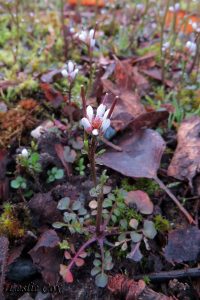 Cardamine hirsuta Family: Brassicaceae
Cardamine hirsuta Family: Brassicaceae
(kahr-DAM-uh-nee hur-SUE-tah)
Common name: hairy bittercress, snapweed
Type: weed; self-seeding annual
Zone: 4 – 8
Height: > 12 in (30 cm)
Spread: 6 in (15 cm)
Aspect: full sun; part shade
Soil: moderate
Water: moderate
Description: An herbaceous self-seeding annual with an erect habit. Dark green leaves form a basal rosette at the base of the stem, or stems. They are pinnately divided into 8-15 round or ovate leaflets, attached at the petiole by short stems. Leaflet edges are gently scalloped, looking like clubs on a deck of cards. There are also leaves growing up the stem, called cauline leaves. They too are pinnately divided, but have fewer leaflets and are usually smaller than the basal leaves. The upper surface of the cauline leaves, the petioles, and the stems are sparsely covered in minute hairs.
 Special Notes: Initially native to Eurasia, hairy bittercress has made it into many countries across the globe…thanks to the global movement of plants. Of particular note, the flowers are “complete”…having both female and male sexual parts. Each flower is also capable of self-pollination. No need to wait for wayward pollinators. Cardamine hirsuta is a prolific seeder with about 20 seeds in each pod and several pods on each plant. Each pod contains a release mechanism which can hurl the seeds up to 3 ft (1 m) away.
Special Notes: Initially native to Eurasia, hairy bittercress has made it into many countries across the globe…thanks to the global movement of plants. Of particular note, the flowers are “complete”…having both female and male sexual parts. Each flower is also capable of self-pollination. No need to wait for wayward pollinators. Cardamine hirsuta is a prolific seeder with about 20 seeds in each pod and several pods on each plant. Each pod contains a release mechanism which can hurl the seeds up to 3 ft (1 m) away.
Its life cycle is quite short for a plant. New seedlings start to appear as soon as temperatures start to warm up in late winter/early spring and there are several generations produced until the plants die as temperatures dip towards winter. The seeds, however, are frost hardy and hibernate through the worst of the winter season…just waiting for spring. Because of this specie’s multi-generations and proficiency in producing good numbers of seeds…some claim as many as 600 in a season from just one plant’s progeny…it is highly recommended the gardener stay on top of the weeding.
In our Zone 7a garden: We have this weed in our garden…thanks to our penchant for combing numerous nurseries and acquiring many wonderful plants over the years. Thankfully, we both love to weed as it is a really good way of being one with the garden. And the experts are not kidding! You must stay on top of this prolific weed!
Posted on January 20, 2017; updated on October 14, 2024

